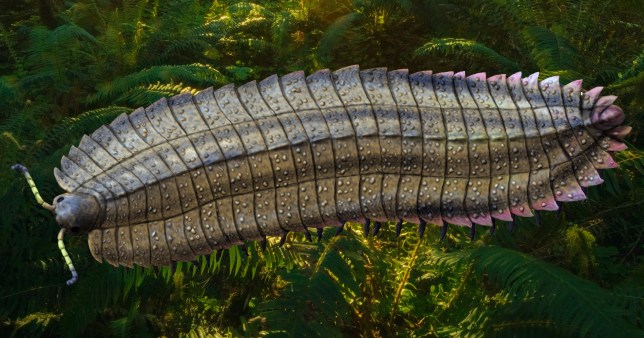Scientists have uncovered a car-sized mega-millipede that walked the earth around 340 million years ago.
After centuries of mystery, the face of the Arthropleura has been unveiled, thanks to two well-preserved fossils.
The arthropod is thought to have lived in forests close to the equator between 346 and million and 290 million years ago during the late Paleozoic era.
Arthopleura could grow to a whopping 8.5 feet long and weigh over 45kg, and their existence has baffled palaeontologists for decades.
The creature had similar characteristics to a millipede, but as experts had never seen its head before they couldn’t work out its relationship to modern arthropods.
But now the head has been unearthed, with its round structure adorned with two short, bell-shaped antennae.
According to new research it also has two protruding eyes like crabs and a small mouth for scavenging leaves and bark.
Like other arthropods, it is likely lived on vegetation and would shed its exoskeleton through an opening on its head.
The fossilized exoskeletons left clues about the size of the creature’s head, but no indication of its facial structure.
But now that more juvenile fossils have been found, experts have finally been able to study the head and find out more about the creature.
A co-author of the study Mickael Lheritier explained: ‘We discovered that it had the body of a millipede, but the head of a centipede.’
Researchers used advanced CT scanning techniques to model the head while also examining the fossils.
The fossils were taken back in the 1980s in a French coal field and were still embedded in rock.
Scans enabled the team to examine hidden details without causing any damage to the ancient fossils.
Palebiologist James Lamsdell, who did not take part in the study, said: ‘We’ve been wanting to see what the head of this animal looked like for a really long time.’
‘When you chip away at rock, you don’t know what part of a delicate fossil may have been lost or damaged.’
Even though the fossils are only two inches long, the researchers believe they can tell us what the Arthropleura was like.
Get in touch with our news team by emailing us at webnews@metro.co.uk.
For more stories like this, check our news page.
MORE : Otters scale fences to steal fish worth up to £30,000 from people’s ponds
MORE : I thought I found a toy in my Shein delivery — then it moved
Get your need-to-know
latest news, feel-good stories, analysis and more
This site is protected by reCAPTCHA and the Google Privacy Policy and Terms of Service apply.


















